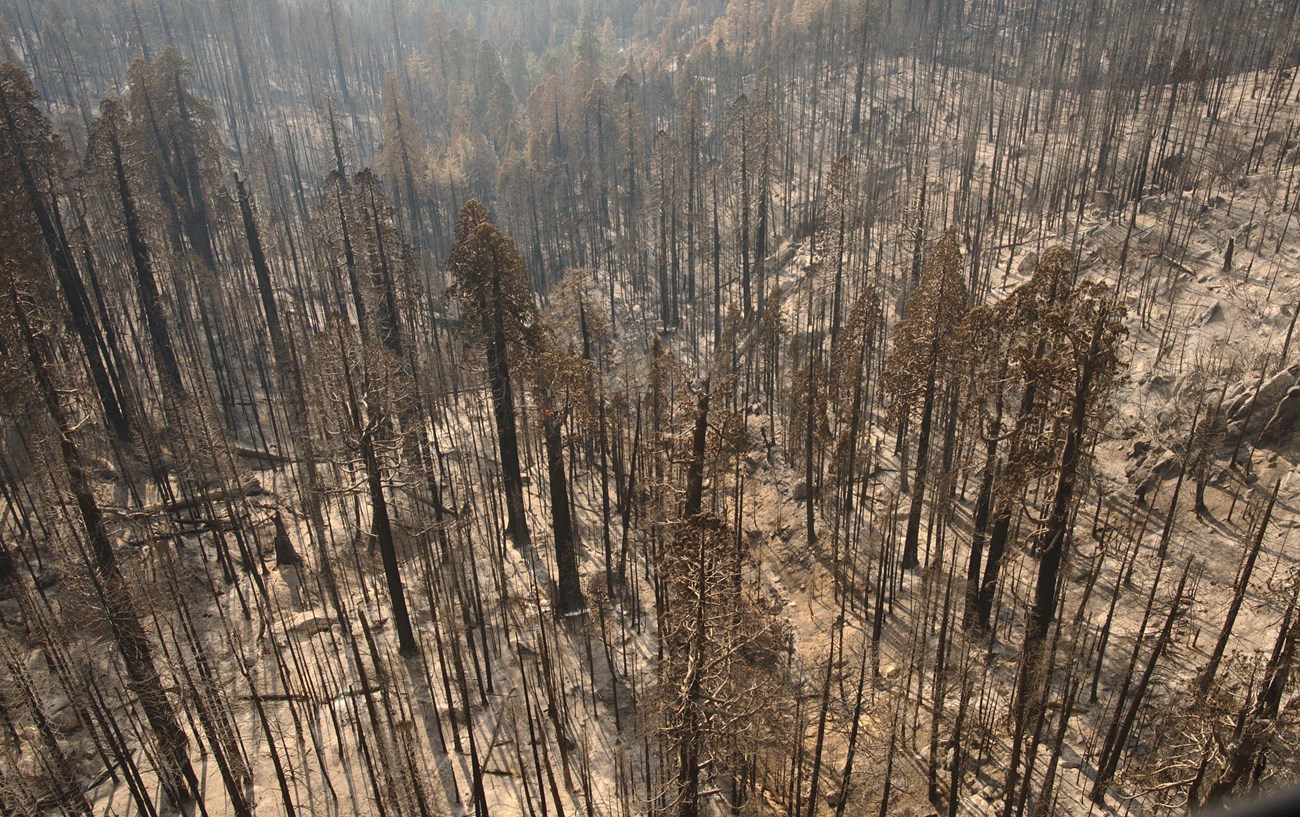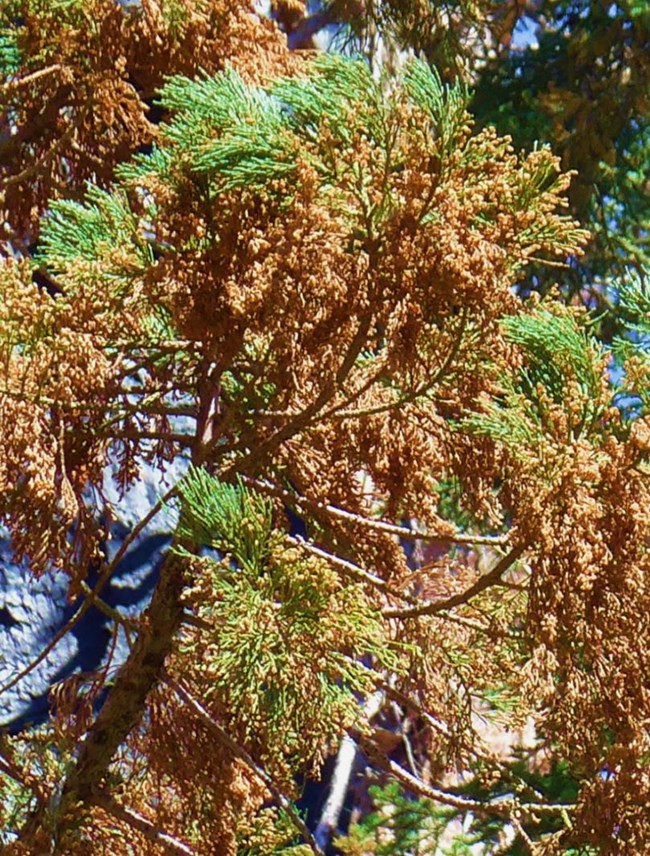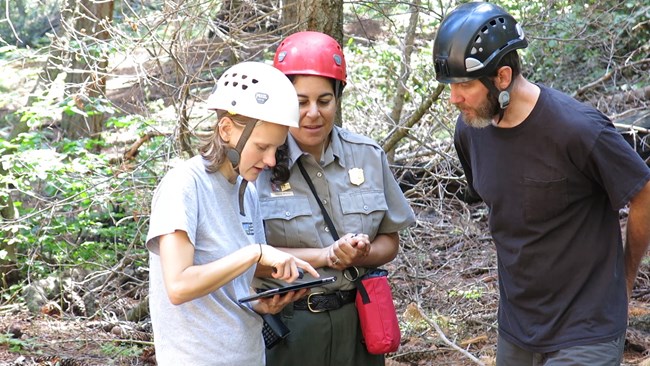Last updated: February 24, 2022
Article
Giant Sequoias Face New Threats

NPS / Anthony Caprio
Giant sequoias are known for their resistance to insects and disease and their fire-adapted life cycle. Prior to the recent severe drought, research about giant sequoia mortality suggested that large sequoias typically died by falling or, occasionally, having extensive crown scorch from fire. Death while standing, unrelated to crown scorch, was almost never observed by scientists who had spent decades working in the Sierra Nevada. And while mature giant sequoias did die from fire impacts, that was a relatively rare event, typically the result of many accumulated injuries over their long lives.
The hotter drought of 2012-2016 appears to have been a tipping point for giant sequoias and other Sierra Nevada mixed-conifer forests. In hotter droughts, unusually high temperatures worsen the effects of low precipitation, resulting in greater water loss from trees and lower water availability. This is an emerging climate change threat to forests. This article provides a brief overview of the following impacts associated with the hotter drought:
- Extensive wildfires resulting in unprecedented fire-caused death of mature giant sequoias
- Native bark beetles killing giant sequoias
- Widespread giant sequoia foliage dieback (primarily 2014)
These were all newly observed phenomena in giant sequoias.
How have recent wildfires affected giant sequoia groves?
Over 85 percent of all giant sequoia grove acreage across the Sierra Nevada has burned in wildfires between 2015 and 2021, compared to only one quarter in the preceding century. Thousands of large giant sequoias (those with trunks 4 feet in diameter or larger) are estimated to have been killed in six recent wildfires (Figure 1), most of those in the 2020 Castle Fire and the 2021 KNP Complex and Windy fires. Based on aerial surveys from a helicopter, fire severity estimates, and sequoia grove maps, 13 to 19 percent of the world's large sequoias are estimated to have died in the Castle Fire and the KNP Complex and Windy fires combined, or 8,431 to 11,897 trees (Shive et al. 2021, Stephenson and Brigham 2020). Upcoming fieldwork will help scientists determine more precise giant sequoia mortality estimates.

NPS / Joshua Flickinger
Conditions contributing to high severity fire in these areas include:
- Fire history of the groves – areas that sustained high levels of giant sequoia mortality typically had not burned in decades, resulting in substantial fuel loads.
- The 2012-2016 drought killed many non-sequoia species of trees (pines, incense-cedars, firs), helping create an increase in existing fuels. While much of the tree mortality was in lower elevation pine forests, the drought also caused elevated mortality (and increased fuels) at mid-elevations where giant sequoias grow.
- Extreme fire weather – In some cases, very low relative humidity and higher than average temperatures resulted in unusually low fuel moistures (amount of moisture in live trees as well as sticks and logs) enabling fire to burn actively day and night. Extreme fire behavior, poor air quality from smoke, and remote, rugged terrain hampered fire control efforts in some areas.
- Some of the groves where many giant sequoias died occurred on warm, dry south-facing slopes, so topography contributed to higher fire severity.
Bark Beetles: A Novel Cause of Death

USGS / Nate Stephenson

USGS photo
Acute Foliage Dieback
Acute foliage dieback occurred in many giant sequoias in Sequoia and Kings Canyon National Parks as a short-term response to the drought. Dieback was most pronounced in 2014, the most severe drought year in the park’s 122-year record. Amounts of dieback on individual trees ranged from none to >75%. The magnitude of dieback was variable between and within groves. The majority of sequoias affected by crown dieback recovered foliage quickly — by the summer of 2015, the affected dead foliage had been shed, and new foliage produced.
Dieback was highest: (1) at low elevations, probably due to higher temperatures, reduced snowpack, and earlier snowmelt; (2) in areas of low adult sequoia densities, which likely reflect intrinsically more stressful sites; and (3) on steep slopes, probably reflecting reduced water availability. Research results suggest that giant sequoia vulnerability to hotter droughts may be spatially quite variable, and that at least some of that variability can be explained by metrics related to site water balance (Stephenson et al. 2018).
Summary
Prior to 2014, scientists recorded only subtle, long-term changes in forest health. During and after the drought, they observed large, abrupt, and novel changes to forests, including in numerous giant sequoia groves. These included: unprecedented numbers of large sequoias dying in severe wildfires, giant sequoias dying from bark beetle attacks, and acute foliage dieback as a short-term adaptation to drought.

Wendy Baxter / University of California, Berkeley
Responding to Change
Responses to these sudden changes will take coordination across organizations managing giant sequoias and with scientists, and non-governmental organizations. The National Park Service is working with partners to create:
- opportunities for increased shared learning in giant sequoia management;
- increased efficiency in planning and implementing management actions that improve forest resilience; and
- stronger public communications around giant sequoia conservation.
While severe wildfire has become a threat to giant sequoias in recent years, prescribed burning remains one of the most important management tools to reduce fuels in sequoia groves, favor regeneration of young sequoias, and increase resilience of these groves to climate change and wildfires.
Increased death of large giant sequoias is just one of many recent and profound changes in the Earth's forests, other wildlands, and oceans. What changes can we make as individuals and a society to help sustain these special places? By sharing current science, rangers and park partners seek to begin conversations about the meaning of change in public lands—places preserved by and for all who care about them.
Perhaps the most powerful defenders of giant sequoias are all those who learn, teach others, and take steps toward a world where sequoias can thrive for thousands of years into the future. (Hazel Galloway, National Park Service Interpreter)
References
Shive, K., C. Brigham, T. Caprio, and P. Hardwick. 2021. 2021 Fire season impacts to giant sequoias. Link to National Park Service web article.Stephenson, N. L., A. J. Das, N. J. Ampersee, K. G. Cahill, A. C. Caprio, J. E. Sanders, and A. P. Williams. 2018. Patterns and correlates of giant sequoia foliage dieback during California’s 2012-2016 hotter drought. Forest Ecology and Management 419-420 (2018): 268-278.
Stephenson, N. and. and C. Brigham. 2020. Preliminary estimates of sequoia mortality in the 2020 Castle Fire. Link to National Park Service web article.
- Duration:
- 8 minutes, 55 seconds
Giant sequoia trees are impressive in size, age, and resilience. This resilience is being tested by climate change and previous management practices. These challenges offer opportunities to research these wonderful trees and develop better ways to support their ability to thrive.
